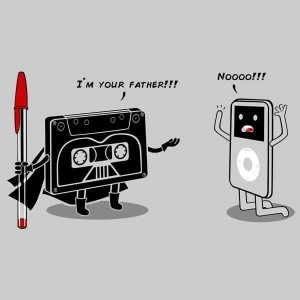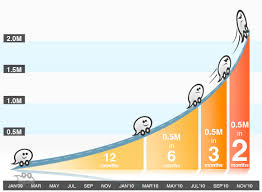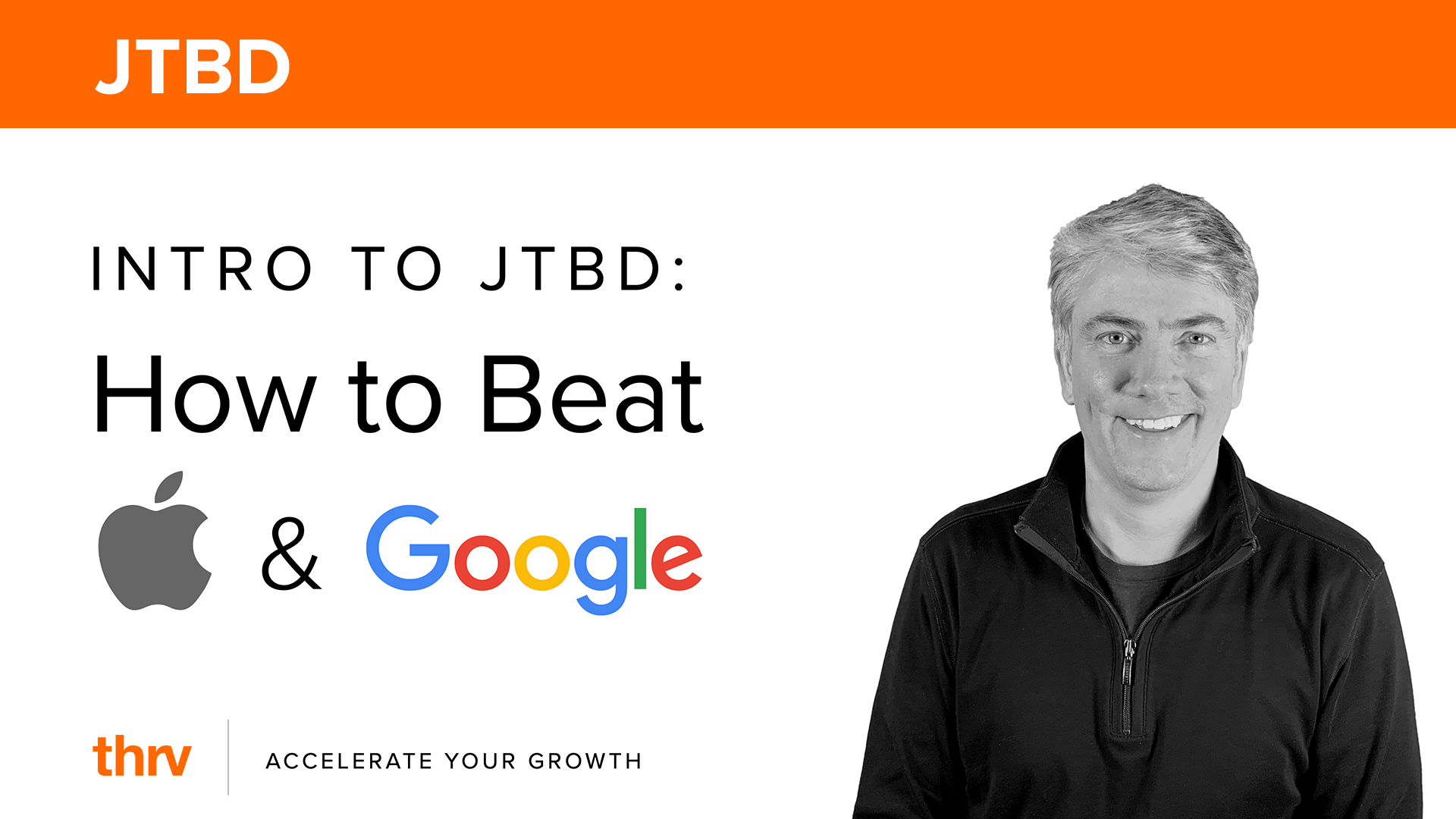October 7, 2016
Clayton Christensen, Jobs-to-be-Done & Competing Against Luck, Part 1

This is a two part series explaining thrv's process for executing Jobs Theory. Part 1: How to Ask the Right Question is about defining the job of your customer, identifying unmet needs, and analyzing the competition. Part 2: Answering the Right Question is about how to build a high-growth product roadmap using Jobs Theory.
Throughout my 25-year career as a Private Equity investor, as a CEO of two Silicon Valley startups backed by A-list VC's, and as a Product Manager at Microsoft, I consistently ran into the same mission critical problem: no one knew how to predict revenue growth. It was easy to predict our costs because we controlled them. However, we struggled to predict our revenue growth because we didn't know what caused people to buy our products. Without a deep understanding of purchasing causes, we couldn't accurately predict how changes to our products would accelerate our revenue growth.
Competing Against Luck
Ten years ago, I found the solution to my problem in Jobs-to-be-Done innovation theory (aka Jobs Theory), the subject of the book Competing Against Luck by Clayton Christensen, Jobs-to-be-Done guru and Harvard Business School professor. The central idea behind Jobs Theory is this: "Your customers are not buying your products, they are hiring them to get a job done."
If you understand what that job is, you can identify what causes customers to hire your products. As a result, you can make improvements to your products that will get the job done better. This is the key to mitigating investment risk and forecasting revenue accurately.
In the book, Clay states, "A job has an inherent complexity to it: it not only has functional dimensions, but it has social and emotional dimensions too." This is why "in practice, seeing a job clearly and fully characterizing it can be tricky."
After a decade of practicing Jobs Theory with companies ranging from $50 million to $50 billion in revenue, I couldn't agree more with Clay. Identifying the job your customers are hiring your product to do is very difficult. Yet for the companies I've worked with, it has been the difference between declining or accelerating revenue growth.
Competing Against Luck is a deep exploration of Jobs Theory, but Clay is clear about "not attempting to be comprehensive or provide a step-by-step manual." In my time working with Jobs Theory, I learned that companies need a step-by-step process to turn the theory of jobs into high-growth products. That's why I started thrv -- to provide jobs-to-be-done training, services, and software that enable executives and product development teams to execute Jobs Theory successfully.
For those of you wondering how to use Jobs Theory to launch great products, here's a step-by-step guide (in two parts) that maps a decade of practice to the theory in Competing Against Luck.
Step 1: Define Your Customer's Jobs
In Competing Against Luck, Clay Christensen and his fellow authors suggest:
...define a job as the progress that a person is trying to make in a particular circumstance...a job has an inherent complexity to it: it not only has functional dimensions, but it has social and emotional dimensions too.
Rather than combine the functional, emotional and social dimensions into one complex job statement, in practice, I've found it easier to separate jobs into 3 different types:
- Functional Jobs
- Emotional Jobs
- Consumption Jobs
Let's look at each.
Functional Jobs
A functional job is the core task, goal or job that customers are trying to accomplish. The key is to define the task or goal independently from any technology, product or service. As Clay says, "We don't 'create' jobs, we discover them."
"Creating a playlist on Spotify" is not a job because it includes a product (Spotify) and a solution (creating a playlist). The question is: why do people create a playlist on Spotify? One answer is to "create a mood with music." This is a more useful articulation of the core functional job. All products evolve and fade away over time. In order to execute the job of creating a mood with music, consumers have "hired" a huge range of products: piano rolls, Victrolas, LPs, eight-track tapes, reel-to-reel tapes, cassettes, CDs, MP3 players, and streaming apps. If you define the job with reference to the technologies consumers have used, you will be trying to hit a moving target. However, the job of creating a mood with music has never changed and will never change. This gives you a stable target for your business. Jobs Theory holds true in B2B and medical markets as we will demonstrate below.

According to Clay, "The circumstance is fundamental to defining the job (and finding a solution for it), because the nature of the progress desired will always be strongly influenced by the circumstance." At thrv, we state this a little differently, but the concept is the same: who is the job beneficiary?
For example, is the job beneficiary a consumer, a driver, a traveler, a parent, a surgeon, a nurse, a patient, a salesperson, a small business owner, a CIO, a technical architect, a database administrator, an engineer? A single person can, of course, be multiple job executors (i.e. a driver, a parent, a patient, and an engineer) all in the same day. In Clay's words, a person can find themselves in different "circumstances."
The job beneficiary is your core customer. The market exists because they are trying to execute a job-to-be-done. While the job beneficiary does not always make the purchase decision (e.g. a procurement officer or a hospital administrator can influence a purchase), your market exists because someone is benefiting from getting the core functional job. There would be no reason to purchase a solution if no one needed the results of the functional job.
At the end of Competing Against Luck, Clay writes, "Defining the job at the right level of abstraction is critical to ensuring that the theory is useful." This is a key step in the innovation process. We use 3 market research techniques to get to the "right level of abstraction."
- Focus on why in customer interviews. Ask your customers why they use a certain product. Why does a salesperson use CRM software? Why does a patient use a step-tracking app? CRM software and health apps are solutions and thus not jobs. Asking why will remove the product (which is ever-changing) from the equation and uncover the job (which is stable).
- Use the Wake-up-in-the-Morning Test. When your job executor wakes up in the morning, do they think, "I have to get this job done today"? Do salespeople wake up wondering how they will acquire customers? Do parents wake up wondering how to instill a behavior in a child? If yes, ask a helpful follow-up, "Did people waking up 100 years ago also need to get this job done?" If not, you likely have included a solution in your job statement and you do not have a stable target for a long-lasting business.
- Use active, goal-driven job verbs. Clay writes, "A well-defined job-to-be-done is expressed in verbs and nouns." But, what kind of verbs? Certain verbs, like "manage," are not helpful in defining a job. For example, "manage lead data" is not a job for a salesperson because it is not the goal (i.e. it is at the wrong level of abstraction). Why does a salesperson want to manage lead data? To acquire customers. Acquire customers is the goal and thus a more useful level of abstraction. Good job verbs are active and goal-driven: determine, understand, learn, acquire, enable, ensure, optimize, create, teach, instill, develop, buy, sell, obtain, identify, detect, mitigate, diagnose, treat, cure, prevent.
Emotional Jobs
We look at emotional jobs separate from the core functional job. This makes it easier to identify the emotions a job executor is experiencing when doing the job and ensures that we don't neglect the functional job. Emotional jobs are important, but if you don't get the functional job done, eventually your customer's negative feelings will take over and they will fire your product.
Emotional jobs come in two flavors: personal and social.
A personal-emotional job is how you want to feel and avoid feeling when executing a job. For example, when getting to a destination on time, drivers want to feel calm and confident that they will arrive on time. They want to avoid feeling anxious about being late.
A social-emotional job is how the job executor wants to be perceived (and avoid being perceived) by others. For example, an IT professional wants to be perceived as valuable to the organization when optimizing a network. A surgeon wants to avoid being perceived as unsympathetic by patients when restoring artery blood flow.
Emotional jobs matter because if two products get the functional job done equally well, customers will choose the one that makes them feel better. For instance, if two different 401k services produce the same rate of return, they get the functional job done equally well. But, if one service hides the day-to-day data, it will make me anxious. I will choose the one that makes the health of my fund more transparent, relieving my anxiety. As Clay writes, "Overcoming customer anxieties is a very big deal."
Consumption Jobs
Consumption jobs are the tasks required to use a solution. Purchase, install, learn to use, interface, maintain, repair, and dispose are all consumption jobs that relate to using a solution.
In the book, Clay doesn't use the same language to discuss Consumption Jobs, but when he talks about "experiences," he often includes Consumption Jobs.
One of the case studies from the book is how American Girl dolls were never sold in traditional toy stores but only in catalogues and then in American Girl stores. The stores in particular turned purchasing a doll (a consumption job) into a special event between a parent and their child. By tightly controlling their sales channels, American Girl improved on the purchase job. It's a great example of how improving consumption jobs can contribute to the whole experience of getting the job done with a product.
Step 2: Identify All the Needs in Your Customer's Job
Knowing the customers functional, emotional and consumption jobs is just the start to practicing jobs theory. As Clay states, “Designed without a clear job spec, even the most advanced products are likely to fail." But, what is a "job spec"?
In our view, a job spec should include all the criteria a customer uses to judge if she can execute the job successfully. We call these criteria the customer needs, and they are metrics. As Clay writes, "A powerful lever to drive job-centric process development and integration is to measure and manage to new metrics aligned with nailing the customer's job.” So how do we identify all the needs (the "new metrics") in your customer's job? First, let's define a customer need in more detail.
We know that all job executors want to execute the job "perfectly," in Clay's words. In our view, this means they want to execute it as fast as possible without any errors and without it going off track -- quickly and accurately. The good news is that speed and accuracy in a functional job can be measured, so we use "time" and "likelihood" as the main metrics to define customer needs in a job.
When drivers are trying to get to a destination on time, they need to reduce the time it takes to determine if an alternative route should be taken due to traffic. When surgeons are restoring artery blood flow, they need to reduce the likelihood of restenosis. When CIOs are enabling secure data use, they need to reduce the time it takes to determine the referential integrity of the data. When consumers are trying to create a mood with music, they need to reduce the likelihood that a song disturbs the mood.
We always structure customer needs the same way. They have a direction (reduce), a metric (time or likelihood), and a goal (e.g. an alternative route, restenosis). This structure makes needs measurable and consistent so you can align your team around objective goals. Competing Against Luck uses the example of Southern New Hampshire University, who focused on the job of "providing [adult learners] with credentials that would improve their professional prospects as quickly and efficiently as possible." Re-focusing on this job generated explosive growth for SNHU. One way SNHU improved their performance on this job was by responding to financial aid inquiries within 10 minutes instead of 24 hours.
This demonstrates how you can define the needs in the job as metrics customers use to judge how quickly and accurately they can get the job done. We would define the job of SNHU's customers as adult learners (the job executors) obtaining credentials to improve their professional prospects (the job-to-be-done). Instead of framing the problem generically as adult learners who want to execute this job "as quickly and efficiently as possible," we would identify all the needs in the job and structure them with a direction (reduce), a metric (time or likelihood), and a goal (e.g. obtain financial aid). This gives us more detail about what "quickly and efficiently" actually means to the job executors.
Responding to financial aid inquiries within 10 minutes reduces the time it takes to determine if you can obtain financial aid. This is just one need in the job, but every job-to-be-done has about 100 customer needs (metrics). Your job spec should include all of these needs to get a full picture of the job. This need structure is useful throughout the process. It helps you identify unmet needs, find competitor weaknesses, generate the best product ideas, and mitigate risk in your product roadmap.
Step 3: Find the Unmet Needs in Your Customer's Job
"The Theory of Jobs to Be Done...focuses on deeply understanding your customers' struggle for progress and then creating the right solution..."
Finding unmet needs is how you precisely articulate and quantify your customers' struggles. A need is unmet if it has high importance but low customer satisfaction. It indicates that the job executor wants something to happen quickly or accurately but is not able to make it happen with their current solution. They are primed to switch to a new, more innovative solution that meets the need. We uncover the unmet needs with a survey that asks job executors to rate each need in the job for importance and satisfaction.
Identifying unmet needs also helps you empathize with your customers. For example, Apple and Google Map did not help drivers "reduce the time it takes to determine an alternate route." You can picture this. Imagine you are driving to a job interview and traffic on the highway comes to a complete stop. It's not rush hour so this is a total surprise. What do you do? Do you get off and try to go a different way? How long is the traffic jam? Maybe a traffic report will come on the radio soon, but your anxiety increases with every passing minute.

Before Waze, you had no way to quickly determine if you should take an alternate route. Waze built a business that Google bought for $1.3 billion by serving this unmet need in the job of getting to a destination on time. Waze's app did this better than Google Maps, Apple Maps, and the radio. As a result, users switched and Waze experienced exponential growth.
Step 4: Segment Your Customers
Marketing 101 teaches us to identify a target customer. With Jobs-to-be-Done, our target is the job executors with the most unmet needs. They are the most underserved customers and therefore the segment who is most likely to buy ("hire") your product to get the job done.
How is this needs-based segmentation different from traditional segmentation?
Clay writes, "Here I am, Clayton Christensen. I'm sixty-four years old. I'm six feet eight inches tall. My shoe size is sixteen. My wife and I have sent all our children off to college. I live in a suburb of Boston and drive a Honda minivan to work. I have a lot of other characteristics and attributes. But these characteristics have not yet caused me to go out and buy the New York Times today."
Clay captures the essential flaw in traditional segmentation: demographics and psychographics do not cause purchases. Age, shoe size, zip code, purchase history, etc. are all examples of characteristics that companies traditionally use to segment customers. This is also true in B2B markets, where companies segment customers by industry classification, number of employees, revenue, etc.
Here is a thought experiment to prove the point that demographics are not the most useful means of segmentation. Could an elderly rural woman who drives an economy car and a young, urban man who drives a luxury sports car both struggle to get to a destination on time in the same way? In other words, could they have the same unmet needs in the job? The answer, of course, is yes. But these two people (or "personas") would never be grouped together in traditional segmentation and so a large portion of the market would be missed.
To execute Jobs Theory, we find customers who rate the same needs as important and unsatisfied and group them together. These are the people most likely to buy your product if it gets the job done better, regardless of their personas. They have the highest levels of frustration and anxiety when executing the job and are likely looking for a new solution.
Step 5: Identify Your Competitors' Weaknesses
Once you have identified the job, found the unmet needs in the job, and segmented your customers, it's time to identify your competitor's weaknesses. In every market there are multiple competitors, but they might not be who you expect. Clay writes, "The competitive field is likely completely different from what you might have imagined."
Did you ever think that Facebook is competing with cigarettes? A smoker taking a break is not just seeking nicotine. Nicotine is a solution to a job. The underlying job is to relax. "From this perspective, people hire Facebook for many of the same reasons. They log into Facebook during the middle of the workday to take a break from work, relax for a few minutes while thinking about other things, and convene around a virtual water cooler with far-flung friends," as Clay points out. The first part of identifying your competitors' weaknesses is to identify the solutions people use to get the job done.
Airlines are not just competing with other airlines to help salespeople acquire customers. They are competing against web conferencing and CRM software. Angioplasty balloon makers are not just competing against other medical devices to help patients with blocked arteries improve their health. They are competing against diet programs, exercise routines, and fitness devices.
Once you see your entire competitive landscape, you can find and measure your competitors' weaknesses by using the unmet needs in your customer's job.
The structure of a customer need (direction, metric, goal) makes this possible. Your team can measure competitive weakness down to the second and the percentage. If the competition attempts to meet a need with a solution that is slow, manual, unreliable, or inaccurate, you have found a competitive weakness. The competitive weakness sets the bar for how well your solution should meet the needs. To get customers to switch, you should target significant improvements over the speed and accuracy of your competition's weak solution.
Asking the Right Question
Now that you've defined your customer's functional, emotional, and consumption jobs, identified the unmet needs, segmented your market, and analyzed how the competition serves these needs for the segment, you have the right question:
What can we do to serve our segment's unmet needs in the job better than the existing solutions?
In Part 2, we'll show you the process for answering this question. If you have any questions or comments, we'd love to hear them. You can leave a comment below, or engage us on Twitter @thrvapp. If you'd like to speak to us directly about thrv and our training program, get in touch with us today.
Posted by Jay Haynes View all Posts by Jay Haynes





